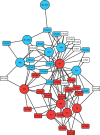A Latitudinal Diversity Gradient in Terrestrial Bacteria of the Genus Streptomyces
- PMID: 27073097
- PMCID: PMC4817263
- DOI: 10.1128/mBio.02200-15
A Latitudinal Diversity Gradient in Terrestrial Bacteria of the Genus Streptomyces
Abstract
We show that Streptomyces biogeography in soils across North America is influenced by the regional diversification of microorganisms due to dispersal limitation and genetic drift.Streptomyces spp. form desiccation-resistant spores, which can be dispersed on the wind, allowing for a strong test of whether dispersal limitation governs patterns of terrestrial microbial diversity. We employed an approach that has high sensitivity for determining the effects of genetic drift. Specifically, we examined the genetic diversity and phylogeography of physiologically similar Streptomyces strains isolated from geographically distributed yet ecologically similar habitats. We found that Streptomyces beta diversity scales with geographic distance and both beta diversity and phylogenetic diversity manifest in a latitudinal diversity gradient. This pattern of Streptomyces biogeography resembles patterns seen for diverse species of plants and animals, and we therefore evaluated these data in the context of ecological and evolutionary hypotheses proposed to explain latitudinal diversity gradients. The data are consistent with the hypothesis that niche conservatism limits dispersal, and historical patterns of glaciation have limited the time for speciation in higher-latitude sites. Most notably, higher-latitude sites have lower phylogenetic diversity, higher phylogenetic clustering, and evidence of range expansion from lower latitudes. In addition, patterns of beta diversity partition with respect to the glacial history of sites. Hence, the data support the hypothesis that extant patterns of Streptomyces biogeography have been driven by historical patterns of glaciation and are the result of demographic range expansion, dispersal limitation, and regional diversification due to drift.
Importance: Biogeographic patterns provide insight into the evolutionary and ecological processes that govern biodiversity. However, the evolutionary and ecological processes that govern terrestrial microbial diversity remain poorly characterized. We evaluated the biogeography of the genus Streptomyces to show that the diversity of terrestrial bacteria is governed by many of the same processes that govern the diversity of many plant and animal species. While bacteria of the genus Streptomyces are a preeminent source of antibiotics, their evolutionary history, biogeography, and biodiversity remain poorly characterized. The observations we describe provide insight into the drivers of Streptomyces biodiversity and the processes that underlie microbial diversification in terrestrial habitats.
Copyright © 2016 Andam et al.
Figures



Comment in
-
History Leaves Its Mark on Soil Bacterial Diversity.mBio. 2016 Jun 7;7(3):e00784-16. doi: 10.1128/mBio.00784-16. mBio. 2016. PMID: 27273826 Free PMC article.
References
-
- Baas Becking LGM. 1934. Geobiologie of inleiding tot de milieukunde. W.P. van Stockum and Zoon, The Hague, The Netherlands.
Publication types
MeSH terms
LinkOut - more resources
Full Text Sources
Other Literature Sources
Miscellaneous

